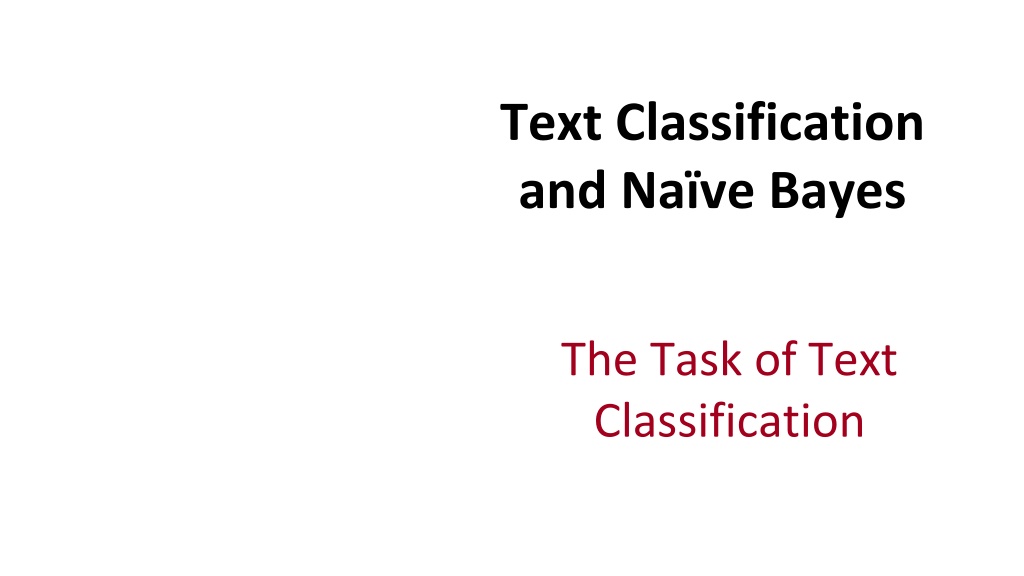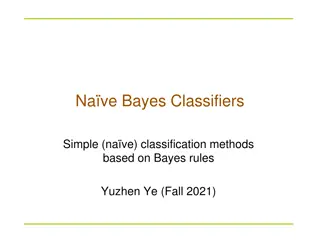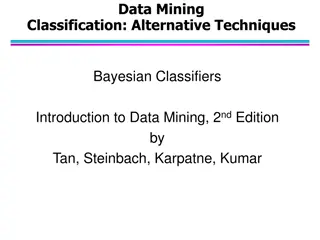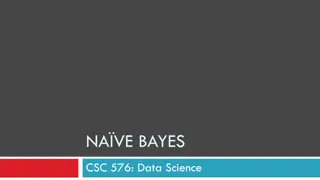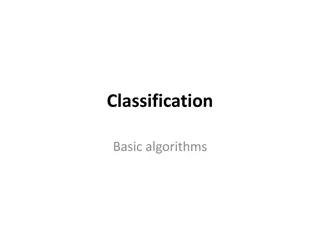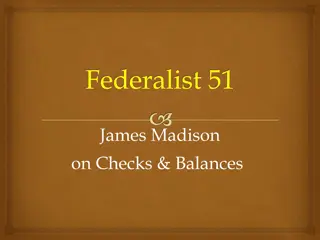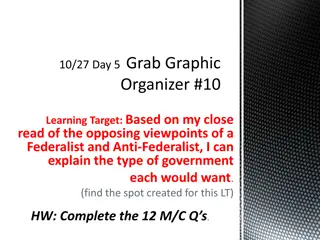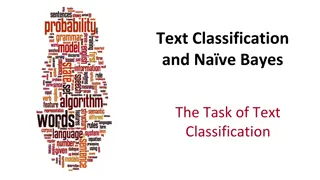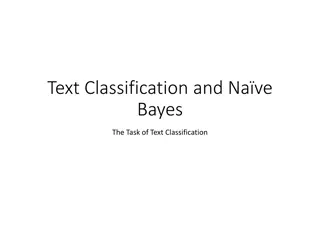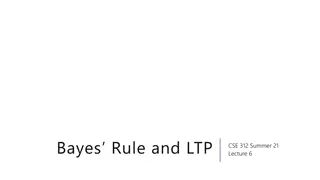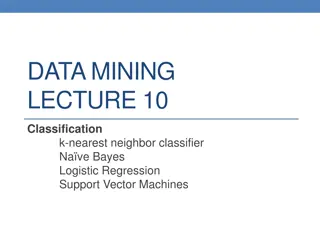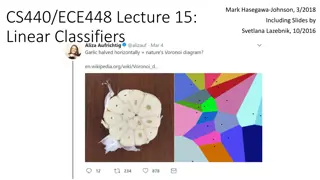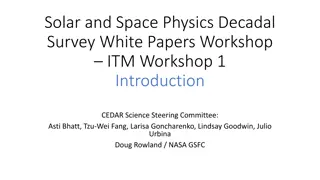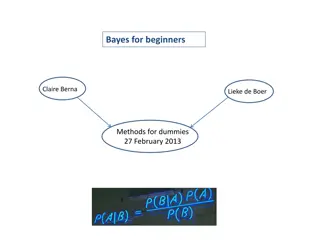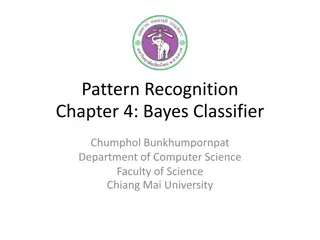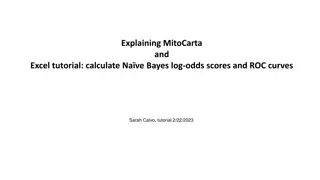Understanding Text Classification Using Naive Bayes & Federalist Papers Authorship
Dive into the world of text classification, from spam detection to authorship identification, with a focus on Naive Bayes algorithm. Explore how Mosteller and Wallace used Bayesian methods to determine the authors of the Federalist Papers. Discover the gender and sentiment analysis aspects of text classification, along with the subject categories covered in formal written texts.
Uploaded on Sep 06, 2024 | 0 Views
Download Presentation

Please find below an Image/Link to download the presentation.
The content on the website is provided AS IS for your information and personal use only. It may not be sold, licensed, or shared on other websites without obtaining consent from the author. Download presentation by click this link. If you encounter any issues during the download, it is possible that the publisher has removed the file from their server.
E N D
Presentation Transcript
Text Classification and Na ve Bayes The Task of Text Classification
Who wrote which Federalist papers? 1787-8: anonymous essays try to convince New York to ratify U.S Constitution: Jay, Madison, Hamilton. Authorship of 12 of the letters in dispute 1963: solved by Mosteller and Wallace using Bayesian methods James Madison Alexander Hamilton
Male or female author? 1. By 1925 present-day Vietnam was divided into three parts under French colonial rule. The southern region embracing Saigon and the Mekong delta was the colony of Cochin-China; the central area with its imperial capital at Hue was the protectorate of Annam 2. Clara never failed to be astonished by the extraordinary felicity of her own name. She found it hard to trust herself to the mercy of fate, which had managed over the years to convert her greatest shame into one of her greatest assets S. Argamon, M. Koppel, J. Fine, A. R. Shimoni, 2003. Gender, Genre, and Writing Style in Formal Written Texts, Text, volume 23, number 3, pp. 321 346
Positive or negative movie review? unbelievably disappointing Full of zany characters and richly applied satire, and some great plot twists this is the greatest screwball comedy ever filmed It was pathetic. The worst part about it was the boxing scenes. 5
What is the subject of this article? MeSH Subject Category Hierarchy MEDLINE Article Antogonists and Inhibitors Blood Supply Chemistry Drug Therapy Embryology Epidemiology ? 6
Text Classification Assigning subject categories, topics, or genres Spam detection Authorship identification Age/gender identification Language Identification Sentiment analysis
Text Classification: definition Input: a document d a fixed set of classes C ={c1, c2, , cJ} Output: a predicted class c C
Classification Methods: Hand-coded rules Rules based on combinations of words or other features spam: black-list-address OR ( dollars AND havebeen selected ) Accuracy can be high If rules carefully refined by expert But building and maintaining these rules is expensive
Classification Methods: Supervised Machine Learning Input: a document d a fixed set of classes C ={c1, c2, , cJ} A training set of m hand-labeled documents (d1,c1),....,(dm,cm) Output: a learned classifier :d c 10
Classification Methods: Supervised Machine Learning Any kind of classifier Na ve Bayes Logistic regression Support-vector machines k-Nearest Neighbors
Text Classification and Na ve Bayes The Task of Text Classification
Text Classification and Na ve Bayes Na ve Bayes (I)
Nave Bayes Intuition Simple ( na ve ) classification method based on Bayes rule Relies on very simple representation of document Bag of words
The bag of words representation seen sweet 2 1 )=c ( whimsical 1 recommend happy 1 1 ... ...
Text Classification and Na ve Bayes Na ve Bayes (I)
Text Classification and Na ve Bayes Formalizing the Na ve Bayes Classifier
Bayes Rule Applied to Documents and Classes For a document dand a class c P(c|d)=P(d |c)P(c) P(d)
Nave Bayes Classifier (I) cMAP=argmax P(c|d) MAP is maximum a posteriori = most likely class c C P(d |c)P(c) P(d) P(d |c)P(c) =argmax c C =argmax c C Bayes Rule Dropping the denominator
Nave Bayes Classifier (II) cMAP=argmax P(d |c)P(c) c C Document d represented as features x1..xn =argmax c C P(x1,x2, ,xn|c)P(c)
Nave Bayes Classifier (IV) cMAP=argmax P(x1,x2, ,xn|c)P(c) c C O(|X|n |C|) parameters How often does this class occur? Could only be estimated if a very, very large number of training examples was available. We can just count the relative frequencies in a corpus
Multinomial Nave Bayes Independence Assumptions P(x1,x2, ,xn|c) Bag of Words assumption: Assume position doesn t matter Conditional Independence: Assume the feature probabilities P(xi|cj) are independent given the class c. P(x1, ,xn|c)=P(x1|c) P(x2|c) P(x3|c) ... P(xn|c)
Multinomial Nave Bayes Classifier cMAP=argmax P(x1,x2, ,xn|c)P(c) c C cNB=argmax P(cj) P(x|c) c C x X
Applying Multinomial Naive Bayes Classifiers to Text Classification positions all word positions in test document cNB=argmax P(cj) P(xi|cj) cj C i positions
Text Classification and Na ve Bayes Formalizing the Na ve Bayes Classifier
Text Classification and Na ve Bayes Na ve Bayes: Learning
Sec.13.3 Learning the Multinomial Na ve Bayes Model First attempt: maximum likelihood estimates simply use the frequencies in the data P(cj)=doccount(C =cj) Ndoc count(wi,cj) count(w,cj) w V P(wi|cj)=
Parameter estimation count(wi,cj) count(w,cj) w V fraction of times word wi appears among all words in documents of topic cj P(wi|cj)= Create mega-document for topic j by concatenating all docs in this topic Use frequency of w in mega-document
Sec.13.3 Problem with Maximum Likelihood What if we have seen no training documents with the word fantasticand classified in the topic positive (thumbs-up)? P("fantastic" positive) =count("fantastic", positive) = 0 count(w,positive ) w V Zero probabilities cannot be conditioned away, no matter the other evidence! cMAP=argmaxc P(c) P(xi|c) i
Laplace (add-1) smoothing for Nave Bayes count(wi,c)+1 count(w,c)+1 ( w V count(wi,c)+1 count(wi,c) count(w,c) ( P(wi|c)= P(wi|c)= w V ) ) = +V count(w,c ) w V
Multinomial Nave Bayes: Learning From training corpus, extract Vocabulary Calculate P(cj)terms For each cj in C do docsj all docs with class =cj Calculate P(wk| cj)terms Textj single doc containing all docsj Foreach word wkin Vocabulary nk # of occurrences of wkin Textj |docsj| P(cj) nk+a P(wk|cj) |total # documents| n+a |Vocabulary|
Text Classification and Na ve Bayes Na ve Bayes: Learning
Text Classification and Na ve Bayes Na ve Bayes: Relationship to Language Modeling
Generative Model for Multinomial Nave Bayes c=China X1=Shanghai X2=and X3=Shenzhen X4=issue X5=bonds 35
Nave Bayes and Language Modeling Na ve bayes classifiers can use any sort of feature URL, email address, dictionaries, network features But if, as in the previous slides We use only word features we use all of the words in the text (not a subset) Then Na ve bayes has an important similarity to language modeling. 36
Sec.13.2.1 Each class = a unigram language model Assigning each word: P(word | c) Assigning each sentence: P(s|c)= P(word|c) Class pos 0.1 I I love this fun film 0.1 love 0.1 0.1 .05 0.01 0.1 0.01 this 0.05 fun 0.1 film P(s | pos) = 0.0000005
Sec.13.2.1 Na ve Bayes as a Language Model Which class assigns the higher probability to s? Model pos Model neg 0.2 I 0.1 I I love this fun film 0.001 love 0.1 love 0.1 0.2 0.1 0.001 0.01 0.01 0.05 0.005 0.1 0.1 0.01 this 0.01 this 0.005 fun 0.05 fun P(s|pos) > P(s|neg) 0.1 film 0.1 film
Text Classification and Na ve Bayes Na ve Bayes: Relationship to Language Modeling
Text Classification and Na ve Bayes Multinomial Na ve Bayes: A Worked Example
Doc 1 2 3 4 5 Words Chinese Beijing Chinese Chinese Chinese Shanghai Chinese Macao Tokyo Japan Chinese Chinese Chinese Chinese Tokyo Japan Class c c c j ? P(c)=Nc Training N P(w|c)=count(w,c)+1 count(c)+|V | Test Priors: P(c)= P(j)= 3 4 1 Choosing a class: P(c|d5) 4 3/4 * (3/7)3 * 1/14 * 1/14 0.0003 Conditional Probabilities: P(Chinese|c) = P(Tokyo|c) = P(Japan|c) = P(Chinese|j) = P(Tokyo|j) = P(Japan|j) = (5+1) / (8+6) = 6/14 = 3/7 (0+1) / (8+6) = 1/14 (0+1) / (8+6) = 1/14 P(j|d5) 1/4 * (2/9)3 * 2/9 * 2/9 0.0001 (1+1) / (3+6) = 2/9 (1+1) / (3+6) = 2/9 (1+1) / (3+6) = 2/9 41
Nave Bayes in Spam Filtering SpamAssassin Features: Mentions Generic Viagra Online Pharmacy Mentions millions of (dollar) ((dollar) NN,NNN,NNN.NN) Phrase: impress ... girl From: starts with many numbers Subject is all capitals HTML has a low ratio of text to image area One hundred percent guaranteed Claims you can be removed from the list 'Prestigious Non-Accredited Universities' http://spamassassin.apache.org/tests_3_3_x.html
Summary: Naive Bayes is Not So Naive Very Fast, low storage requirements Robust to Irrelevant Features Irrelevant Features cancel each other without affecting results Very good in domains with many equally important features Decision Trees suffer from fragmentation in such cases especially if little data Optimal if the independence assumptions hold: If assumed independence is correct, then it is the Bayes Optimal Classifier for problem A good dependable baseline for text classification But we will see other classifiers that give better accuracy
Text Classification and Na ve Bayes Multinomial Na ve Bayes: A Worked Example
Text Classification and Na ve Bayes Precision, Recall, and the F measure
The 2-by-2 contingency table correct tp fn not correct fp tn selected not selected
Precision and recall Precision: % of selected items that are correct Recall: % of correct items that are selected correct tp fn not correct fp tn selected not selected
A combined measure: F A combined measure that assesses the P/R tradeoff is F measure (weighted harmonic mean): 1 b + 2 ( ) 1 PR = = F 1 1 b + 2 P R a + - a 1 ( ) P R The harmonic mean is a very conservative average; see IIR 8.3 People usually use balanced F1 measure i.e., with = 1 (that is, = ): F = 2PR/(P+R)
Text Classification and Na ve Bayes Precision, Recall, and the F measure
Text Classification and Na ve Bayes Text Classification: Evaluation
